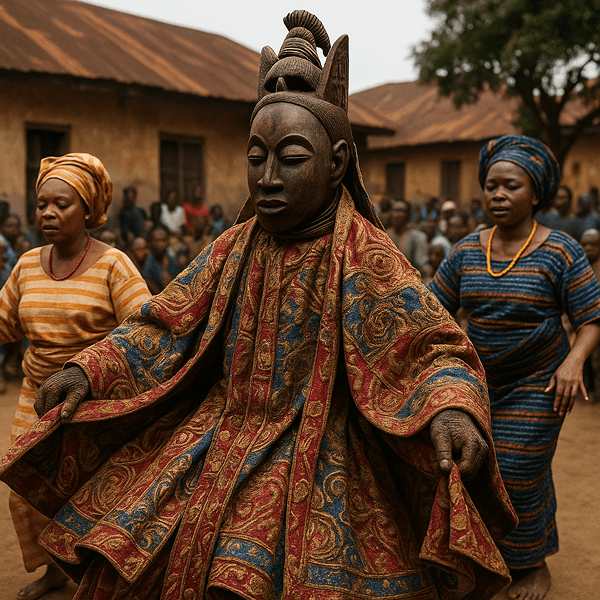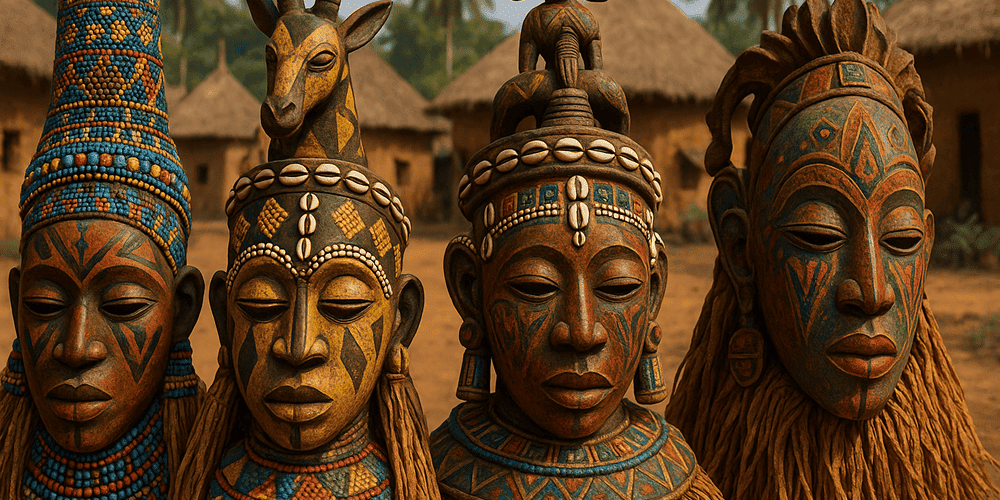Yoruba masks are among the most iconic and culturally significant artifacts in West African art. Originating from the Yoruba people, an ethnic group primarily located in southwestern Nigeria, as well as parts of Benin and Togo, these masks are celebrated for their striking visual qualities and deeply symbolic meanings. Yoruba masks typically feature elaborate designs, with characteristic elements such as stylized human faces, geometric patterns, and sometimes animal motifs. The masks can be adorned with intricate carvings, colorful pigments, beads, or even textiles. Most Yoruba masks are instantly recognizable by their bold expressions, high foreheads, almond-shaped eyes, and detailed ornamentation, reflecting not just aesthetic preferences but also cultural values and spiritual beliefs. The tradition of mask-making among the Yoruba dates back centuries, with roots believed to extend as far back as the early kingdoms of Ife and Oyo.
Historical Origins
The origins of Yoruba masks can be traced to the formation of early Yoruba city-states between the 11th and 15th centuries CE. The word “mask” in Yoruba is often rendered as “ẹ̀bọra,” referring to both spirit and face, highlighting the mask’s role as a vessel for spiritual forces. Initially, masks were crafted for ritual and ceremonial purposes, often linked to ancestral veneration and religious festivals. Over time, the design and role of these masks evolved, reflecting historical events, changes in religious practices, and contact with neighboring cultures. Notable mentions of Yoruba masks appear in early colonial travelogues, as well as in archaeological finds, such as terra-cotta and bronze heads from Ife, which influenced later wooden mask designs. The development of masking traditions within the Yoruba was also shaped by a complex network of secret societies and cults, such as the Egungun and Gelede, each with their own stylistic and functional requirements.
Cultural Significance and Symbolism
Yoruba masks serve as powerful symbols within their native culture, embodying connections between the physical and spiritual worlds. They are used to invoke ancestral spirits, honor deities known as Orishas, and protect communities from harm. Ritual performances involving masks are believed to facilitate communication with the divine, mediate social order, and bring blessings or fertility. Many myths surround Yoruba masks; for instance, the Gelede mask tradition is rooted in stories about “the mothers” (powerful female spirits) and their influence over communal well-being. The Egungun masks are associated with ancestral spirits, who are thought to return to earth during masquerades to offer guidance or warnings. The use of masks is thus deeply embedded in the social, religious, and ethical fabric of Yoruba society, marking significant events such as funerals, harvests, and rites of passage.
Materials and Craftsmanship
Traditional Yoruba masks are predominantly carved from wood, chosen for its symbolic and practical qualities. Artisans, known as “awo,” employ tools such as adzes, knives, and chisels to shape the masks, often working under the guidance of spiritual leaders. Decorative techniques include painting with natural pigments, inlaying with cowrie shells or beads, and attaching textile elements or raffia. Each region within Yoruba land has its own stylistic preferences; for example, masks from the Oyo region tend to feature more geometric abstraction, while those from Ekiti and Ijebu areas might be more naturalistic. Color plays a significant role, with red symbolizing vitality, white denoting purity, and black representing the unknown or the spiritual realm. The complexity and care involved in mask-making reflect the object’s sacred status and the high social esteem accorded to master carvers.
Functions and Uses
Yoruba masks are integral to a variety of ceremonial and performative contexts. Most notably, they appear in rituals such as the Egungun masquerade, where masked dancers embody ancestors, and the Gelede festival, which celebrates female power and fertility. Masks are also used in theatrical performances, storytelling sessions, and communal celebrations. Over time, the functions of Yoruba masks have adapted; while their primary use remains ritualistic, they are increasingly seen in cultural festivals, art exhibitions, and even contemporary dance performances. In modern settings, Yoruba masks continue to inspire new interpretations while maintaining their connection to traditional values and community identity. It is worth noting that, much like the famous Dogon Tribe Masks of Mali, Yoruba masks have found audiences and admirers far beyond their place of origin.

Regional Variations
Within the Yoruba-speaking region, mask styles and uses can vary considerably. For example, the Egungun masks of Oyo are distinct in their layered textile costumes and elaborate superstructures, while the Gelede masks of Ketu are known for their colorful, helmet-like forms often surmounted by sculptural tableaux. In contrast, the Epa masks from Ekiti region are monumental, sometimes weighing up to 50 kilograms, and feature complex multi-figure compositions. These regional distinctions not only reflect local histories and beliefs but also demonstrate the adaptability and creativity of Yoruba artisans. Comparatively, while Yoruba masks share similarities with other West African mask traditions, such as those of the Dogon or Bamana peoples, their use of symbolism, performative context, and technical execution set them apart.
Famous Examples and Collections
Some of the most renowned Yoruba masks are housed in major museums around the world, including the British Museum, the Musée du Quai Branly in Paris, and the Metropolitan Museum of Art in New York. These collections feature masks from various subgroups, each illustrating the richness and diversity of Yoruba art. Notable archaeological finds, such as the bronze and terra-cotta heads from Ife, have also contributed to scholarly understanding of Yoruba mask traditions. In addition, several prestigious private collections, as well as dedicated African art galleries, offer opportunities to view these masks up close. For those interested in authentic examples or learning more, websites like toddmasks.com provide valuable resources and curated selections of traditional masks
